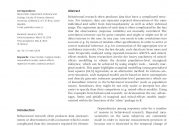Content
Behavioural research often produces data that have a complicated structure. For instance, data can represent repeated observations of the same individual and suffer from heteroscedasticity as well as other technical snags. The regression analysis of such data is often complicated by the fact that the observations (response variables) are mutually correlated. The correlation structure can be quite complex and might or might not be of direct interest to the user. In any case, one needs to take correlations into account (e.g. by means of random-effect specification) in order to arrive at correct statistical inference (e.g. for construction of the appropriate test or confidence intervals). Over the last decade, such data have been more and more frequently analysed using repeated-measures ANOVA and mixed-effects models. Some researchers invoke the heavy machinery of mixed-effects modelling to obtain the desired population-level (marginal) inference, which can be achieved by using simpler tools – namely marginal models. This paper highlights marginal modelling (using generalized least squares [GLS] regression) as an alternative method. In various concrete situations, such marginal models can be based on fewer assumptions and directly generate estimates (population-level parameters) which are of immediate interest to the behavioural researcher (such as population mean). Sometimes, they might be not only easier to interpret but also easier to specify than their competitors (e.g. mixed-effects models). Using five examples from behavioural research, we demonstrate the use, advantages, limits and pitfalls of marginal and mixed-effects models implemented within the functions of the ‘nlme’ package in R.



